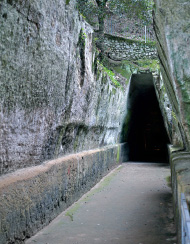![]()
THE modern visitor to Naples goes inevitably to Pompeii. For our eighteenth-century predecessors the Roman sights west of Pozzuoli held an equal priority. These used to be best explored on foot, as I discovered some years ago when it proved impossible to hire a car at short notice. A suburban train stops at Baia, near the so-called Temple of Diana, in reality part of the huge, partly excavated complex of an imperial palace. I headed west, across a low ridge, to descend to Lago Fusaro, which is separated by a narrow spit of land from the sea. Across the lake is Vanvitelli’s Casino Reale, built in 1782 for King Ferdinand IV of Naples, floating as it seems on the surface of the water, and to the south looms the dramatic silhouette of Ischia.
Turn north for the road to Cuma. After about three kilometres you reach the amphitheatre which is cut into the hillside; an arcade, much eroded, presided over the terraces and fields of the nearby farm, but is now officiously fenced off. Further on is the site of the Roman town, and beyond this are the ruins of the sanctuary of the Cumaean Sibyl on the flank of the ancient acropolis above the coast. The metalled road goes directly to the official entrance, but it was more satisfying, 200 metres or so from the turn, to cross a field on the right to the insubstantial remains of a temple and then follow the Cripta Romana, the impressive tunnel which cuts through the hill from east to west. Of the Roman road tunnels in the area, this was the most readily accessible and few classical structures are more suggestive. While I trust it may long be spared the restorer’s attentions, and echo to the sounds not of tourists but of birds unaccustomed to unwanted disturbance, it is frustrating that access is now all but impossible.
The Sibyl was venerated by the Greek colonists who settled at Cuma, and it was they who in the sixth century BC embarked on the elaborate excavations of the rock which were extended some 200 years later. A gallery, over 130 metres long, was cut through the soft tufa. This is lit by windows on the west looking out to the sea. There are subsidiary arms to the gallery, and at the end is the rectangular room with three niches in which the Sibyl made her oracular pronouncements. To the north stretches the terraced acropolis, with the podium of tufa blocks of the Temple of Apollo and scattered vestiges of numerous other buildings; a road with Roman paving leads up to the husk of the Temple of Apollo fringed by ilexes on the summit. The drama of the place inspired Salvator Rosa’s Landscape with the Cumaean Sibyl of the Wallace Collection, and the views over the coast are astonishing, not least in the benign sunlight of a spring afternoon. But it is time to turn inland. Make for the Arco Felice, built under the Emperor Domitian (AD 81–96), a viaduct for the road from Rome to Pozzuoli. One is again reminded how ordered was the infrastructure of ancient Rome.

Approach to the Grotto of the Sibyl.
Alas, it is no longer possible to follow the Roman road to Pozzuoli by the Grotta di Cocceio – named after Cocceius, the architect who built it under Agrippa, the Emperor Augustus’s associate – the tunnel a kilometre in length that cuts through the Monte Grillo to Lake Avernus. So the pedestrian must make a long detour by way of the smaller Lake Lucrinus. Lake Avernus is a perfect example of a volcanic crater, circled almost completely by steep wooded slopes. The place must always have exercised its spell upon the human imagination. Virgil regarded it as the entrance to the Underworld; Richard Wilson and other eighteenth-century painters responded to its magic. Few Roman remains are more beautifully placed than the so-called Temple of Apollo on the eastern flank of the lake, originally part of a bath complex, with a substantial circular chamber set in an octagonal structure. The reflections of the building stretch across the glassy surface of the water in the failing evening light.